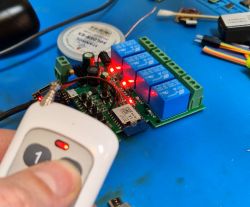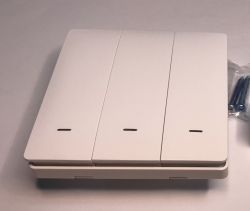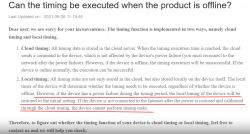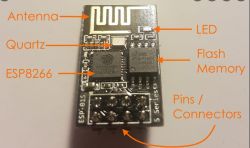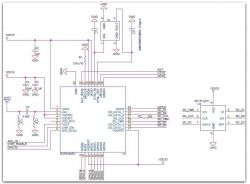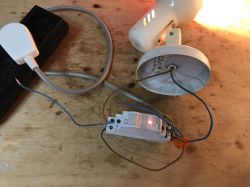 .
.
Hello my dears. .
Here I will present an unusual Tuya relay that (unlike many others) is able to remember and execute its work schedule even if the WiFi connection is lost. This is something new, as the Tuya/SmartLife devices I've tested previously relied entirely on the manufacturer's cloud and didn't even timer locally. The product in this theme is different - as the manufacturer itself emphasises several times. Will it work in practice? Let's find out.
Purchase product .
I found the product under " SINOTIMER TM609 Home Smart 18mm 1P WiFi Remote APP Control Circuit Breaker Timing Switch Staircase Timer Din Rail Universal 110V 220V AC Input " for around £100. Below is a screenshot of the offer:
 .
.
The product features:
- compatibility with the Tuya/SmartLife app available on Android and iOS, connection via WiFi network
- the short-circuit relay is not connected to the mains, so that, for example, a 24 V device can be controlled
- operation from 100 to 240V AC 50/60Hz
- 16A relay
- dimensions 70*86*18mm
- mounting on DIN 35mm rail
- possibility of connecting an additional momentary pushbutton (apart from the one on the housing) to switch the status of the relay
- possibility to set a timer and an operating schedule (on/off at a given time), where these settings are remembered and executed even if the WiFi network is lost (the controller module inside remembers these settings and the current time and tries to execute them even if there is no internet)
Promotional graphics:
 .
.
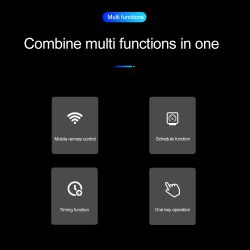 .
.
 .
.
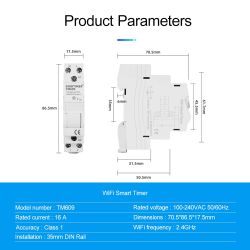 .
.
Connection - please note that the shorted contact is not hardwired to 230V (as is the case with some Sonoff and similar), which is also a plus.
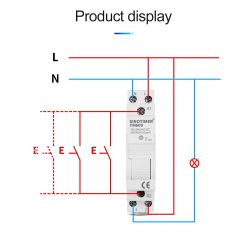 .
.
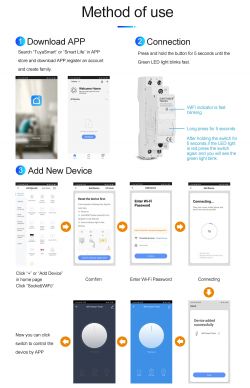 .
.
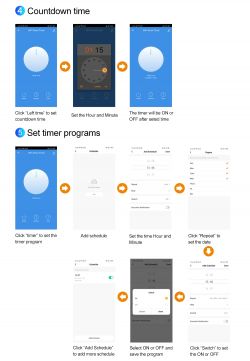 .
.
Shipping, contents of set .
I placed the order on 2022-01-01, the package arrived on the 5th of January. Very fast, still considering the New Year and Sunday (it fell on the 2nd). Hand delivery.
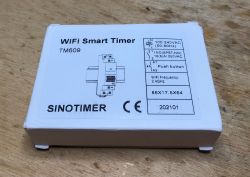 .
.
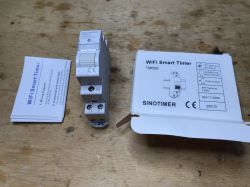 .
.
In the instructions, the manufacturer emphasises that this product has the ability to remember the schedule even if the WiFi network is absent ( "If the product is disconnected from the network, the timer retains all programs set up by Mobile App and works according to the set programs" ):
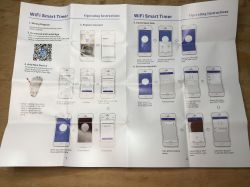
 .
.
NOTE - this product remembers its working schedule and executes it without WiFi, but of course it will not execute without WiFi automation/scenarios like "turn on light when motion sensor detects presence" etc. etc. A WiFi network is already required for this.
Pairing with Tuya application .
As standard with no problems. I used the iPhone app this time. The product is under the "Energy" tab:
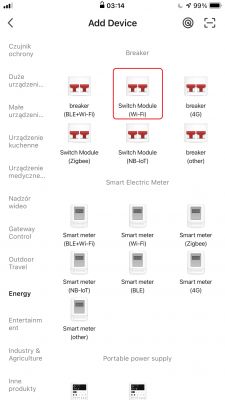
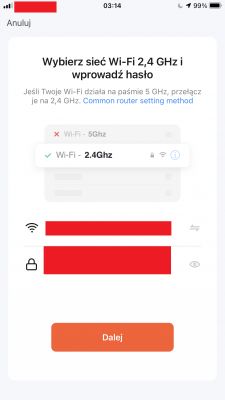
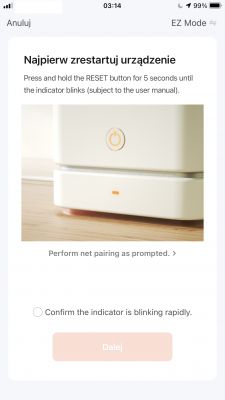 .
.
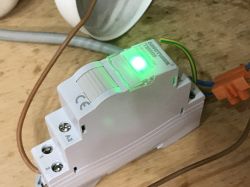
 .
.
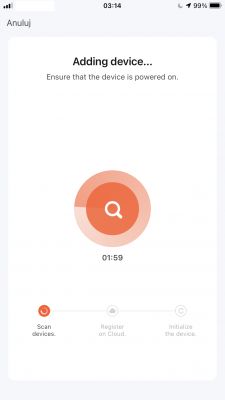
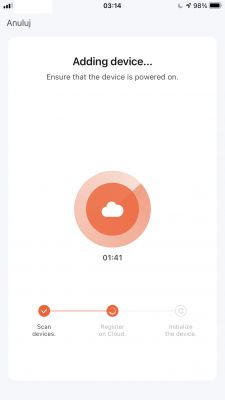
 .
.
Interface in the application:
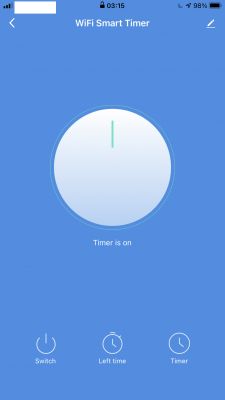
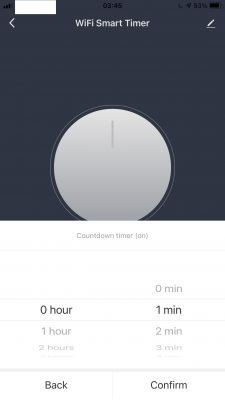
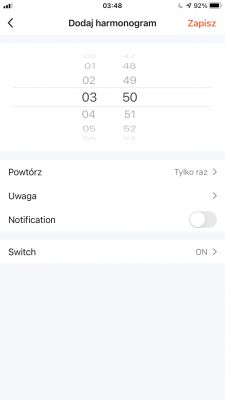
Does it actually hold the schedule after WiFi is turned off? .
I tested this several times, both with the Countdown option (i.e. "turn off in 10 minutes" etc) and the Schedule option ("Turn light on Fridays at 7pm").
For the test, I switched the router off the power, depriving the whole house of internet (as well as depriving the LAN).
4:33am - let's set the schedule to 4:40am and turn the router off:
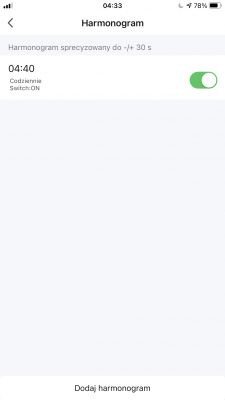 .
.
NOTE - the state of the relay is determined by "Switch:O n", i.e. it will turn it on. This "Toggle" (switch) on the application GUI is from turning on the action execution itself.
O 4:40:
 .
.
It works! Several tests show that the product does indeed remember the schedule without WiFi access.
The topic is interesting in that I found information about it on Tuya's FAQ:
https://support.tuya.com/en/help/_detail/K9d1qifd5qtcp

I post Tuya's official position above. In a nutshell, there are two implementations of timer handling, one local, one cloud-based and it depends on the specific device that is being used. Couldn't they have done it better?
Does the product hold the previous state when power is lost? .
I was already about to give a positive verdict, but was still tempted to check something else....
What happens when the relay is off and we cut the power to it and restore it after a period of time?
The product remembers the state before power was lost, but the light flashes for a while. At first I thought there was a relay shorted by default, but not.... so there must be an unwanted high state on the relay output for a while during ESP booting, and probably before it boots (or before it reads the previous setting from memory) this moment passes and the light flashes....
Can this controller be controlled by a phone on the same WiFi network when the WiFi itself has no internet access? .
The mobile phone was disconnected from WiFi. I then disconnected the main internet cable from the router (WAN), disabled mobile data on the phone and connected it to the same WiFi as the subject device was.
The device was detected by the phone and could be controlled.
Interior TM609 .
Opening this case is quite difficult and problematic. You have to undermine several catches, plus you have to be careful which side you undermine from, because essentially the housing is in three parts (right, left, and the "centre" screw terminals):
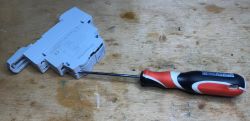 .
.
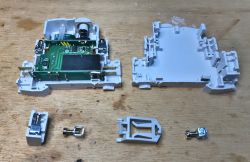 .
.
There are two plates inside:
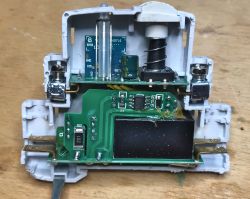
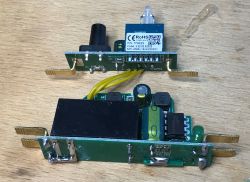 .
.
The module from the middle is the TYWE2S (ESP8266), but with access to the RX/TX there is a little trouble (you would have to solder to the small pads), the IO0 in general is on the case only:
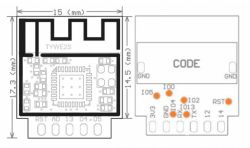 .
.
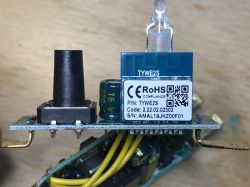 .
.
There is a varistor on the input, you can also see an MB10S rectifier bridge, SM7055-12 transformerless power supply circuit (12V):
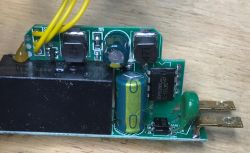 .
.
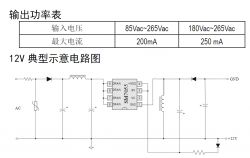 .
.
This small transistor Y1 (ss8050) switches the relay, this is what controls the ESP. The relay is 12V:
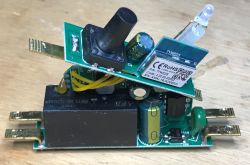 .
.
The SM7055-12 chip gives us 12V, but the ESP8266 needs 3.3V. The voltage is converted here by an MC34063A in a step-down converter configuration (no ordinary LDO):
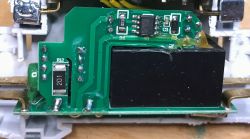 .
.
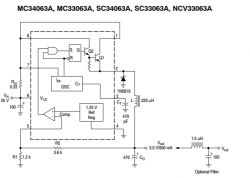 .
.
so there are three wires going to the board from the ESP8266, ground, 3.3V and the signal to the base of the relay switching transistor.
Below is a short sketch of the connections I made when analysing the board:
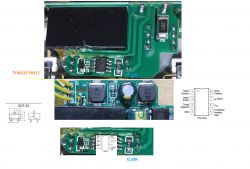 .
.
These two chokes coded 471 (470µH) have different roles - one is from MC34063A, the other from SM7055.
Tasmota compatibility .
Tasmota is an alternative, open-source batch for the ESP8266 allowing independence from the manufacturer's servers, compatible with products such as the one in the topic. Often when doing reviews I try to upload it and specify how it needs to be configured, but here I don't need to do that as the TM609 is already shown as tested and supported by Tasmota:
https://templates.blakadder.com/sinotimer_TM609.html
 .
.
Pin roles (pin 12 is relay) confirmed, I checked with a multimeter (there is of course still a base resistor between pin 12 and the base of the transistor).
Template tasmots:
{"NAME":"Sinotimer TM60","GPIO":[0,0,0,0,0,52,0,0,21,9,0,0,0],"FLAG":0,"BASE":18}
If you want to upload Tasmota to this device, I also recommend trying Tuya-convert:
https://github.com/ct-Open-Source/tuya-convert
My Polish-language tutorial: https://www.elektroda.pl/rtvforum/topic3769864.html
Summary .
This product is considerably more expensive than ordinary Sonoffs and their clones and its price is only somewhat justified. It does indeed remember and execute the schedule even in the situation of a complete WiFi network outage, which is a very big plus, as at one time I tested some SmartLife or there eWeLink outlets and there was no such possibility there. The schedule setting was there, of course, but it only worked when WiFi was available. I'm just wondering why this isn't available in other products of this type? Or maybe the manufacturers have already updated their software and a simple "Tuya Smart Switch" can do this too?
Apart from that, the TM609's strengths are the possibility to connect an additional button to control the relay "manually" and the isolation of the relay output from the network (so you can switch e.g. the. 24V).
Inside, the circuit is based on the SM7055 (12V supply for the relay), the MC34063A (generates 3.3V for the ESP) and the TYWE2S (ESP8266). I attach the SM7055 datasheet note (the other circuits have already appeared on the forum).
Cool? Ranking DIY Helpful post? Buy me a coffee.





